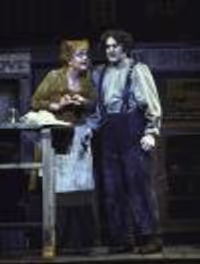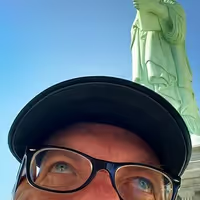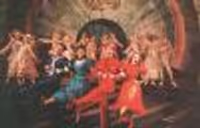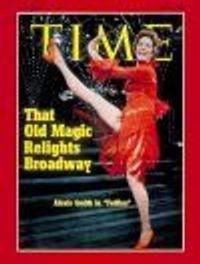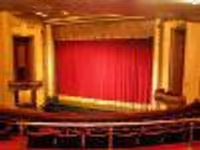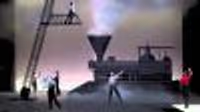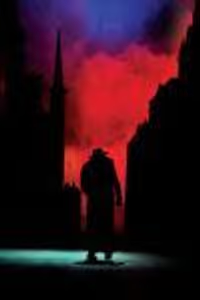FOLLIES 1971 Video Footage (and some Merrily 1981)
Deester2
Swing Joined: 6/14/11
#101FOLLIES 1971 Video Footage
Posted: 6/17/11 at 12:42pmBumping this up so people can get a look at my videos.
Deester2
Swing Joined: 6/14/11
#102FOLLIES 1971 Video Footage
Posted: 6/17/11 at 12:57pm
I did these, synchronizing audio to video. Here are the links again.
Loveland:
http://www.youtube.com/watch?v=QoBRHhRMCOI
Loveland, version 2:
http://www.youtube.com/watch?v=4iK_4ZbXCpY
Buddy's Blues:
http://www.youtube.com/watch?v=P7rM3ozL8m8&feature=related
Lucy and Jessie:
http://www.youtube.com/watch?v=AmexU4Qd0HM&feature=related
Rain on the Roof/Ah, Paris/Broadway Baby
http://www.youtube.com/watch?v=5fvkHB3MA4s
The Right Girl
http://www.youtube.com/watch?v=CmAttoJ_kmY
#103FOLLIES 1971 Video Footage
Posted: 6/23/11 at 9:41pm
Deester put up John McMartin singing "The Road You Didn't Take":
http://youtu.be/oTWezTaM2u0
Watch the way the ghosts move in and out. Watch the way Dorothy Collins sits and folds herself into a pretzel watching him, loving him. And watch the way she says "I remember him, Ben...I even think I loved him...once" BEFORE the final chord not after, as in recent productions.
#104FOLLIES 1971 Video Footage
Posted: 6/23/11 at 9:59pmFabulous! Thanks Deester for all of these. A real treat.
lizabombs
Chorus Member Joined: 5/13/11
#105FOLLIES 1971 Video Footage
Posted: 6/23/11 at 10:46pmIs it too much to hope that there's footage of Dorothy Collins singing "In Buddy's Eyes"?
#106FOLLIES 1971 Video Footage
Posted: 6/23/11 at 10:50pmThere's about 10 seconds of dubbed footage from that number.
lizabombs
Chorus Member Joined: 5/13/11
FIG
Swing Joined: 8/15/09
#108FOLLIES 1971 Video Footage
Posted: 6/24/11 at 9:12am
WOW, Dexter. Thank you so much. That was wonderful.
FIG
#109FOLLIES 1971 Video Footage
Posted: 6/24/11 at 8:02pm
What Deester's done with all the footage is really amazing. I've been fortunate enough to have had it for several years and I'm glad that more people are getting to see it now.
To go back to stuff discussed earlier in the thread, it's correct that the footage with actual live sound is all from a dress rehearsal in Los Angeles. It seems possible that more was shot and just hasn't turned up or been passed on, though of course some of it may no longer exist (if, indeed, there was more).
Some of the silent footage may be from Boston, but I'm not an expert on figuring out this kind of thing from costume details and stuff. Some of the silent footage is from Los Angeles. Some is probably from Broadway. And the stuff shot from the wings was supposedly shot by one of Florence Klotz's assistants on closing night, but I"ve heard different things about whether it was closing night on Broadway or closing night in Los Angeles. I think it was probably closing night on Broadway.
Some other miscellaneous things brought up earlier in the thread:
In Boston, Suzanne Rogers was listed as Roscoe's Daughter. Although Rogers was in the show from the beginning, she didn't take over as Young Phyllis till L.A. Alexandra Borrie was the Broadway replacement in the role.
Helon Blount died in 2005. She was married to Keith Kaldenberg, from the original cast of The Most Happy Fella (and other shows).
I've never heard about a 60 Minutes episode on Sondheim back in 1971 or so. I know that I didn't see it. I've never seen it mentioned in articles on Sondheim on TV, including the one that's linked.
http://www.sondheimreview.com/v7n4.htm
There may have been such an episode, but I'm surprised that I've never heard anything about it. So I'm a tiny bit skeptical.
Rita O'Connor and Rita Rudner are both listed among "Singers and Dancers" in later playbills
The TOFT Company video was shot on closing night of the national tour in D.C. There's also an audio of that performance.
Eric wrote:
"They were floor mikes, although Follies was more complex than most shows at the time, I believe they also had mikes specifically pointed at key areas further upstage where key moments would take place. Follies also was one of the first shows to use some pre recorded tapes mixed in (I believe for the finale of Who's That Woman and the Loveland breakdown, if not other places), as well as using backstage dancers to make the tap sounds for Who's That Woman. If you read Everything Was Possible, they go into some detail about the disaster much of this caused in try out performances--out of sync use of the pre taped vocals, etc.
"I actrually don't knwo when body mikes became common--but floor mikes really seemed to start up in the 60s (probably partly when more electronic instruments were used in the pits--Sw3eet Charity and Promises Promises being two obvious examples). Of course some rock shows like Hair (I think) and Jesus Christ Superstar as well as Grease used hand held mikes.
"(I once got in a big fight with a poster on here who claimed that any performer who needed to be miked to do A Chorus Line wasn't respecting the strengths of the original cast who did it without any amplification, which of course is completely fault, although they didn't have body mikes, at least not at first."
I think there wasn't was any pre-recorded stuff in the "Chaos" out of Loveland, but I can't be sure of that.
Floor mics for Broadway musicals reportedly go back as far as Du Barry Was a Lady in 1939. They didn't start to become common till later in the 1940s. Richard Rodgers said that Carousel was the last Rodgers and Hammerstein to be completely unamplified.
There were musicals, usually more operatic ones (e.g., Candide, The Most Happy Fella), that eschewed amplification, but by the early 1950s, floor mics and area mics were pretty standard. A couple of shows in the 1970s went without any amplification (The Grass Harp, the revival of The Most Happy Fella), but, sadly, they didn't start a trend. Even Porgy and Bess used mics in the Uris, though I'm not sure they used them when it moved to the Hellinger.
Perhaps you're thinking of soundboards. Promises was reportedly the first Broadway show to use a real soundboard. Before that, it was all extremely primitive.
Many recordings that people think are soundboards were probably recorded off a squawk-box, or stage monitor, in some dressing room. We know that some recordings were done that way. Before 1968 or so, I'm not sure it even would really have been very feasible to record something through the sound system. (Of course, some people refer to recordings that were clearly recorded by someone sitting in the audience as soundboards, which puzzles me. Do they not know what a soundboard is? Can they not tell the difference?)
I believe that no one wore a mic in Follies on Broadway, although I wonder about the chorus boys in "Loveland," whose voices always sounded a bit unnaturally loud and tinny. Perhaps they were actually pre-recorded.
It seems that this may have changed in Los Angeles and that the principals may have worn body mics there, perhaps because the Shubert's acoustics weren't good, or perhaps just to be on the safe side in a new theatre.
It seems that the first person to wear a body mic on Broadway was either Helen Traubel in Pipe Dream (Mordden seems to be saying that in his Rodgers and Hammerstein book, but it's hard to tell if that's really what he means and of course he offers no source) or Lena Horne in Jamaica.
Anna Maria Alberghetti famously wore one in Carnival. Channing in Dolly! wore one and it seems that Streisand wore on in Funny Girl.
Hal Prince seems to have tried to avoid using them until Sweeney in that acoustical nightmare of a theatre made them necessary for most of the principals, although Ken Jennings and Merle Louise didn't wear them. And at least early in the run, Cariou's wasn't always on.
I could be wrong, but I don't think that anyone wore a body mic during the original run of A Chorus Line. Certainly, no one wore one when the show opened. But, yes, there were stage mics.
Updated On: 6/24/11 at 08:02 PM
Brick
Broadway Legend Joined: 11/21/06
#110FOLLIES 1971 Video Footage
Posted: 6/24/11 at 8:58pm
"And watch the way she says "I remember him, Ben...I even think I loved him...once" BEFORE the final chord not after, as in recent productions."
That's my favorite part of the clip.
#111FOLLIES 1971 Video Footage
Posted: 6/25/11 at 6:55amThere is a certain lunacy to the fact that, as late as Follies, shows weren't recorded for posterity. We had the ability to tape the shows twenty years before that. Broadway made, I believe, a terrible mistake letting the unions discourage recording for archival purposes. So many great performers will be forgotten when we all pass on, while the Hollywood stars will be available forever (or until the DVD rots).
#112FOLLIES 1971 Video Footage
Posted: 6/25/11 at 3:08pm
allmylife, you're so right. And even when we can glean solo start turns from the 50's and 60's courtesy of those Tony-night Best-Of-Broadway compilations, it still pains us to never know what the full stage production they starred in looked and felt like.
#113FOLLIES 1971 Video Footage
Posted: 7/8/11 at 6:51pm"It's like a movie in my head that plays and plays. It isn't just the bad things I remember. It's the whole show."
#114FOLLIES 1971 Video Footage
Posted: 7/11/11 at 11:22pmI never dreamed I would see this footage again; to see Alexis Smith, Gene Nelson, Ethel Shutta do their numbers brings back amazing memories of the glory that was "Follies". Yes, I will continue to see new productions of "Follies" but nothing can ever be quite the same as the brilliant Prince/Bennett staging or the original cast performing these numbers for the first time. Thank you so much for posting this!
#115FOLLIES 1971 Video Footage
Posted: 7/12/11 at 10:11am
In regard to what former cast members did post FOLLIES:
Dortha Duckworth was a Irene Ryan replacement in PIPPIN.
Immediately following the closure of FOLLIES in L.A. Yvonne de Carlo flew to Australia
to succeed Cyd Charise (playing the Ruby Keeler role of Sue Smith) in the Australian /New Zealand tour of NO, NO, NANETTE. A new number was added to the show for her, Youman's More Than You Know, however that took some convincing as she was determined to do I'm Still Here !
Updated On: 7/12/11 at 10:11 AM
#116FOLLIES 1971 Video Footage
Posted: 7/12/11 at 7:12pm
We've always had the technology to archive these shows, just not the will, or the willpower to fight those who stand in the way of recording these performances for the future.
An entire performance of "On The Town" was recorded in 1944. Occasionally, small snippets appear on youtube. It's absolutely amazing to watch.
Interestingly enough, an entire rilent recording of "Me and My Girl" was shot by an Australian travelogue crew in London in the 1930s (and the show was broadcast live in 1938 on fledgeling television by the BBC. Can you imagine seeing that?
Finally, there is a great deal of footage from original broadway productions in the Pathe, Corbis and Gettyimages online libraries from the 1920s and 30s in London. Amazing stuff, including "Show BoaT," "Music In The Air" and "Rose Marie."
Sadly, nothing by the Astaires.....
#118FOLLIES 1971 Video Footage
Posted: 8/29/11 at 2:45am
I realize this thread is for Follies videos, but I didn't want to start a new thread just for these clips from the original production of "Merrily We Roll Along":
"Rich And Happy"
http://www.youtube.com/watch?v=IIRGxJfBOhw
"Polo Lounge Scene (Part 1)"
http://www.youtube.com/watch?v=Pxd7bhol5nI
"Now You Know (Dance Break)"
http://www.youtube.com/watch?v=5m5ViVUfv6k
If these are inappropriate for this thread I'll delete them.
#119FOLLIES 1971 Video Footage
Posted: 8/29/11 at 7:37amThey are ENTIRELY appropriate. I'll even amend the thread title to let people know.
#121FOLLIES 1971 Video Footage
Posted: 8/29/11 at 9:09am
YAY! ![]()
Then there is a complete video recording of Merrily somewhere!?
#122FOLLIES 1971 Video Footage
Posted: 8/29/11 at 9:45am
This thread is going to get CRAAAAZY
Like It Was
#123FOLLIES 1971 Video Footage (and some Merrily 1981)
Posted: 8/29/11 at 10:01amAs much as a mess as this production was, when Ann Morrison launched into "Like It Was," it was like seeing another "In Buddy's Eyes."
Phyllis Rogers Stone
Broadway Legend Joined: 9/16/07
#124FOLLIES 1971 Video Footage (and some Merrily 1981)
Posted: 8/29/11 at 11:43amClapYoHands, there are at least two.
Videos


